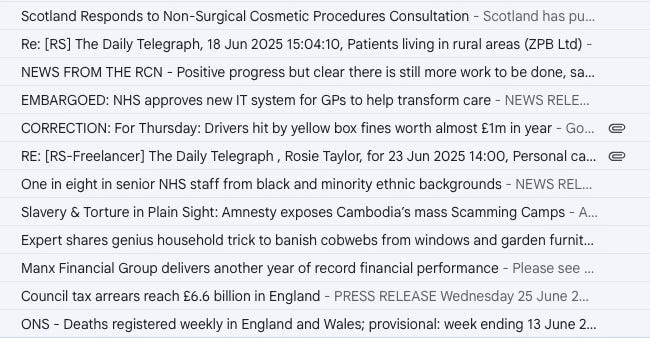It’s no secret that journalists receive a lot of press releases - but what else in our inboxes might be stopping us noticing your pitch?
I kept track of every email I received for a month to discover whether it really is the volume of press releases that is the biggest drain on journalists’ time, or whether something else is going on.
What I found surprised me, and it might surprise you too.
Because although, yes, I did get hundreds (literally) of unsolicited releases and commentary emails, the main drain on my time and ability to pick up pitches was something else - and there’s something we can all do about it!
As an experiment, I took June as an example and looked at all the emails I’d received. I may have deleted a few spammy ones on arrival, but otherwise I counted a total of 1,177 emails that month.
A big disclaimer: As a freelance journalist, I receive a fraction of the emails staff journalists get. This is partly because I have been militantly taking myself off mailing lists, but it’s also because fewer people target me with their press releases.
So take my totals here with a pinch of salt (staff journalists can get 1,000 emails a DAY) but, based on my experience as a staff journalist, I suspect the types of email I describe below are very similar across all journalist inboxes.
I roughly categorised all these emails into:
Press releases, notices and announcements
Reactive commentary in response to news events
Exclusive pitches
These were all the unsolicited emails I received. On top of those, were all the emails that those pitches and stories generated, including:
Discussions with PRs & contacts (e.g. providing statements in response to stories, providing information after an interview or pitch, etc)
PR-related admin (e.g. arranging product samples or making travel arrangements for an event)
Contact with editors (e.g. editors commissioning me and/or asking questions about a story) and clients requesting my media training services
And then there was everything else:
Work admin (e.g. chasing payments, sorting accounts, signing paperwork, etc)
Personal stuff (mainly newsletters about journalism and other things like insurance renewals)
And here’s how that all broke down - and what it means for how you should be pitching to journalists:
Keep reading with a 7-day free trial
Subscribe to Get Featured to keep reading this post and get 7 days of free access to the full post archives.



